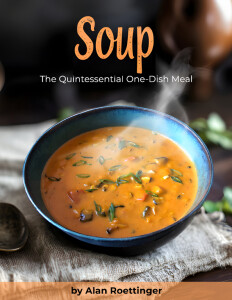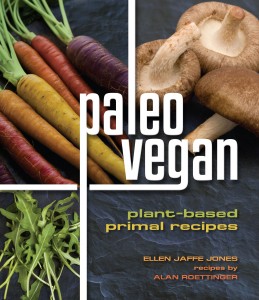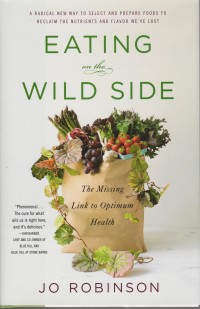 Such an injustice!
Such an injustice!
A truly exceptional minestrone, with an intoxicatingly enticing aroma fully capable of capturing and stimulating the appetite of total strangers who may happen to pass under your kitchen window–and far from doing it any justice, the picture makes it look like pond scum! Not a good introduction, I know, but I just had to get that out of the way (after all, I–mea culpa–took the bloody picture).
An Italian lady from Torino showed me the original version of this minestrone, and I like it much better than the southern Italian one most Americans are familiar with, which is more tomato-(and meat broth)-based. “Minestrone” would translate roughly as “big soup,” and in traditional Italian dining the soup is the first course (preceded by antipasti, or appetizers, then followed by pasta, meat, fish, a sweet, and ending with cheeses and fruits). Sometimes an intermezzo (an interval between courses–usually a few bites of lemon sorbet) is served to cleanse the palate between meat and fish courses. It always seemed to me that when so much follows the soup, it should be as light and palate-teasing as possible. I know it seems a bit oxymoronic to have “big soup” in the same sentence as “palate-teasing,” but if you think like an Italian it makes perfect sense. These people love to eat.
In the original version, all the vegetables are simmered in water until tender first, then salt and a flourish of olive oil added at the end. I don’t ever plan to serve five courses after this dish, so I go for a richer, more palate-satisfying effect. My variations, for fuller flavor: I sauté the onion, celery, leeks, garlic, and carrots in a little olive oil first, and then let them sweat a while over very low heat to develop and concentrate their flavors. When the liquid released has been absorbed and the vegetables are almost dry, I add water, vegetable bouillon cubes, and the other vegetables. The rest is fairly standard. The beans are cooked separately and added last, so I don’t have to stand there and stir every couple of minutes to keep them from sticking (and burning).
The main thing I like about this soup is the color–nearly everything in it is green, with eye-appealing accents of carrot, pumpkin, and cannellini. The version I learned also featured tubetti (little tube-shaped pasta), but I’m headed into a gluten-free zone these days, so I left them out. The beans, however, are essential. As my good friend Giorgio once stated to me with is signature air of professorial authority, “Any minestrone must have fagioli.” That’s Italian for beans, and–not that it was ever up for debate–I concur.
I’m taking some liberties here, using a couple of unorthodox ingredients, but I’ve kept to the spirit of the original. Here’s what’s in it: olive oil, onion, celery, leek, garlic, carrot, zucchini, green beans, asparagus, broccoli stems, peas, spinach, Swiss chard, Tuscan kale, “regular” kale, parsley, potatoes, pumpkin, rich vegetable broth, cannelini beans, and my secret ingredient, a dab of pesto, stirred in just before serving. It’s so easy to overeat this stuff!
If you’re wondering how I make pesto without Parmesan cheese, I admit I had doubts about the possibility of accomplishing this myself. I don’t favor imitation cheese (or imitation anything, frankly), so the question of using that processed vegan faux-Parmesan never came up. Instead, what happened was serendipitous…
One day, my wife had harvested about four cups of fresh basil to make pesto (the right way, with pecorino Sardo and Parmesan cheeses), and asked if we had any pine nuts. We didn’t, but I suggested she try using some of the macadamias I just happened to have in the freezer. So she put everything except the cheese into the food processor and blasted it until it was pretty well smooth. Then, just before she was going to add the cheese for a final whirl, I stuck a spoon into the mixture and tasted it.
Now, I haven’t eaten any cheese for a couple of years, so I may not be the best judge in this case, but that pesto tasted amazing to me just the way it was at that moment. I think it’s the uniquely grainy-unctuous texture and unusual flavor of the macadamias that provides just enough of the taste sensations you get from ground Parmesan cheese to spark up my taste memory just enough to fill in the gaps. Whatever. I’m putting a version of this new pesto in my next book–that’s how good I think it is!







Hey Alan! Ooooh, pesto makes me so happy. And with macadamia nuts?! Yum!
On the collard wraps: Yep, I blanched them! Good call! Nothing gets past you.